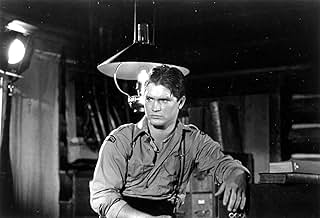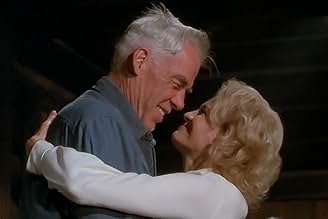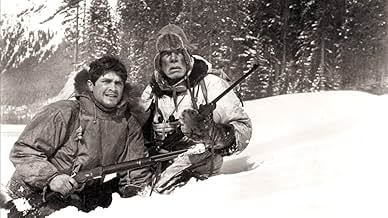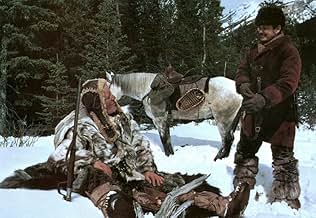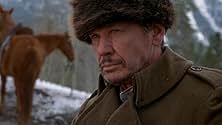IMDb RATING
6.9/10
8.8K
YOUR RATING
In 1931 Canada, Yukon trapper Johnson has a feud with a dog owner who later retaliates by publicly accusing Johnson of murder and thus triggering a police manhunt in the wilderness.In 1931 Canada, Yukon trapper Johnson has a feud with a dog owner who later retaliates by publicly accusing Johnson of murder and thus triggering a police manhunt in the wilderness.In 1931 Canada, Yukon trapper Johnson has a feud with a dog owner who later retaliates by publicly accusing Johnson of murder and thus triggering a police manhunt in the wilderness.
Richard Davalos
- Beeler
- (as Dick Davalos)
- Director
- Writers
- All cast & crew
- Production, box office & more at IMDbPro
Featured reviews
I have always been intrigued by this film, mostly because of the fantasy it suggests, and even obtained a VHS copy to look it over more closely. Using the leads posted by other readers, I have been able to glean the following facts from various Internet and library resources concerning the strange tale of The Mad Trapper of Rat River, played in Death Hunt by Charles Bronson;
a] A man referring to himself as Albert Johnson [identified post mortem by associates as Albert Nelson, although that was also an assumed name] arrived in the Aklavik area and brought attention onto himself from a large purchase of ammunition, a new shotgun, and an inexplicable refusal to get himself a trapper's license. Johnson ran afoul of a Constable Edgar Millen [Lee Marvin's character] during the New Years season of 1931-32 after his apparent meddlings with the traps of some of the local types, who suggested that he had gone bonkers in the isolation of the mountains.
b] Two posses did in fact make seperate trips to Johnson's handmade cabin [measuring 8 feet by 8 feet] and one of the Mounties did in fact have a brief encounter with Johnson through an open window; The first time he simply wouldn't answer their knocks, and the second time he shot a Mountie through his closed door with a .38 automatic. A third posse, with Const. Millens, then made the 80 mile dogsled trip and blew up Johnson's cabin after he again refused to acknowledge them.
c] After they blew up his cabin, Johnson did indeed jump up out of a foxhole he had been hiding in, firing a sawed off shotgun and a .22 repeater with the stock removed. The Mounties retreated, and Johnson slipped away in the darkness.
d] A resulting "death hunt" did indeed ensue, set entirely above the arctic circle, and by the first-time ever use of wireless radios by law enforcement, kept the public of Canada and America riveted with their newspaper and wire reports of the two week long manhunt that was the O.J. Simpson crime case of it's day.
Johnson proved a remarkable adversary, using every trick in the book to confound his pursuers, and managed to survive the nightly -40 tempetures with little or no supplies or survival gear. They did manage to corner him on one occasion; there was a gunfight, Constable Millens was killed, and Johnson escaped by climbing a sheer cliff with his bare hands in the dead of night during a blizzard.
e] A bush pilot and former WW1 air ace became involved in the pursuit, not only by resupplying the posse and flying out wounded men, but played an invaluable role in tracking Johnson after he had made his initial escape, using another wireless radio to vector in the ground pursuit in another law enforcement first. He damn near well almost escaped too, though he was finally cut down in a hail of lead after keeping the authorities at bay for 48 days.
f] The whole case was dubbed "The Mad Trapper of Rat River" incident by the press owing to the locals' contention that Johnson had gone cabin happy. He was found to be carrying a $2400 bankroll when searched, and I have found two references to "gold teeth" or gold fillings; The natives of the area had a fable about "The Trapper who steals the gold from men's teeth" that may have been attributed to Johnson after he was found to have some gold dental work in his posession.
Whether they were his or someone else's is unknown, but their presence plus all that cash led to a rumor that he got rich by prying folks' gold fillings out. This has never been substantiated, and the "Mad Trapper" name was pinned to him before these revelations came to light. To this very day, Johnson's actual identity remains a complete mystery, and his bid for freedom one of the most remarkable examples of man surviving the elements.
NOW, with that in mind, Death Hunt's scriptwriters took a few liberties with the facts to create a more romanticized tale;
- The conflict with the locals is initiated by having Bronson break up a dog fight, making his character sympathetic when compared to the dirt bags who pick a scrap with him afterwards.
- William Beckamn's character of Old Bill is introduced to provide a way for Bronson's character to survive the film after Lee Marvin manages to blow Bill's face off with a single slug. Nice shootin'.
- Lee Marvin's Sgt. Millens also survives and is credited with the man who killed Albert Johnson. Maybe the producers though this was a way of paying homage to Millen's memory.
- The pilot is turned into a jerk to create a "new world vs. old values" conflict with Marvin, then provided with a machine gun equipped biplane to he can gun down Apollo Creed and reinforce the senselessness of it all. The actual pilot. a Capt. "Wop" May, was widely regarded as a hero for the role he played.
- The film was shot during the spring and summer thaw so that characters could wander around in open jackets and sweaters. Much of the pursuing posse footage looks like it was filmed on a snowed over golf course somewhere; we never get a feel that these men are actually battling against the elements.
- The one scene that Bronson and Marvin share is so strangely shot and edited as to suggest that the two actors were not on the set at the same time. Watch it closely -- you can never see both men's faces in the same shot.
Yet I will always have a soft spot for Death Hunt -- it is probably the first R rated film I ever saw. It would be interesting to see a more historically accurate account of the Mad Trapper comitted to film; think of this as the fanciful and romanticized version.
If you have ever dreamed of taking a pack of supplies, a rifle and a dog up into the mountains and saying To Hell With Civilization, this film was made for you.
a] A man referring to himself as Albert Johnson [identified post mortem by associates as Albert Nelson, although that was also an assumed name] arrived in the Aklavik area and brought attention onto himself from a large purchase of ammunition, a new shotgun, and an inexplicable refusal to get himself a trapper's license. Johnson ran afoul of a Constable Edgar Millen [Lee Marvin's character] during the New Years season of 1931-32 after his apparent meddlings with the traps of some of the local types, who suggested that he had gone bonkers in the isolation of the mountains.
b] Two posses did in fact make seperate trips to Johnson's handmade cabin [measuring 8 feet by 8 feet] and one of the Mounties did in fact have a brief encounter with Johnson through an open window; The first time he simply wouldn't answer their knocks, and the second time he shot a Mountie through his closed door with a .38 automatic. A third posse, with Const. Millens, then made the 80 mile dogsled trip and blew up Johnson's cabin after he again refused to acknowledge them.
c] After they blew up his cabin, Johnson did indeed jump up out of a foxhole he had been hiding in, firing a sawed off shotgun and a .22 repeater with the stock removed. The Mounties retreated, and Johnson slipped away in the darkness.
d] A resulting "death hunt" did indeed ensue, set entirely above the arctic circle, and by the first-time ever use of wireless radios by law enforcement, kept the public of Canada and America riveted with their newspaper and wire reports of the two week long manhunt that was the O.J. Simpson crime case of it's day.
Johnson proved a remarkable adversary, using every trick in the book to confound his pursuers, and managed to survive the nightly -40 tempetures with little or no supplies or survival gear. They did manage to corner him on one occasion; there was a gunfight, Constable Millens was killed, and Johnson escaped by climbing a sheer cliff with his bare hands in the dead of night during a blizzard.
e] A bush pilot and former WW1 air ace became involved in the pursuit, not only by resupplying the posse and flying out wounded men, but played an invaluable role in tracking Johnson after he had made his initial escape, using another wireless radio to vector in the ground pursuit in another law enforcement first. He damn near well almost escaped too, though he was finally cut down in a hail of lead after keeping the authorities at bay for 48 days.
f] The whole case was dubbed "The Mad Trapper of Rat River" incident by the press owing to the locals' contention that Johnson had gone cabin happy. He was found to be carrying a $2400 bankroll when searched, and I have found two references to "gold teeth" or gold fillings; The natives of the area had a fable about "The Trapper who steals the gold from men's teeth" that may have been attributed to Johnson after he was found to have some gold dental work in his posession.
Whether they were his or someone else's is unknown, but their presence plus all that cash led to a rumor that he got rich by prying folks' gold fillings out. This has never been substantiated, and the "Mad Trapper" name was pinned to him before these revelations came to light. To this very day, Johnson's actual identity remains a complete mystery, and his bid for freedom one of the most remarkable examples of man surviving the elements.
NOW, with that in mind, Death Hunt's scriptwriters took a few liberties with the facts to create a more romanticized tale;
- Bronson's Abert Johnson is now a decoarted war veteran trained in Special Ops, which accounts for his hardiness, comfort with weapons and wealth of survival skills.
- The conflict with the locals is initiated by having Bronson break up a dog fight, making his character sympathetic when compared to the dirt bags who pick a scrap with him afterwards.
- The dog is then killed to provide Bronson with an understandable motive to blow someone's head off and escalate the confrontation. Poor doggie...
- William Beckamn's character of Old Bill is introduced to provide a way for Bronson's character to survive the film after Lee Marvin manages to blow Bill's face off with a single slug. Nice shootin'.
- Lee Marvin's Sgt. Millens also survives and is credited with the man who killed Albert Johnson. Maybe the producers though this was a way of paying homage to Millen's memory.
- The pilot is turned into a jerk to create a "new world vs. old values" conflict with Marvin, then provided with a machine gun equipped biplane to he can gun down Apollo Creed and reinforce the senselessness of it all. The actual pilot. a Capt. "Wop" May, was widely regarded as a hero for the role he played.
- The film was shot during the spring and summer thaw so that characters could wander around in open jackets and sweaters. Much of the pursuing posse footage looks like it was filmed on a snowed over golf course somewhere; we never get a feel that these men are actually battling against the elements.
- The one scene that Bronson and Marvin share is so strangely shot and edited as to suggest that the two actors were not on the set at the same time. Watch it closely -- you can never see both men's faces in the same shot.
Yet I will always have a soft spot for Death Hunt -- it is probably the first R rated film I ever saw. It would be interesting to see a more historically accurate account of the Mad Trapper comitted to film; think of this as the fanciful and romanticized version.
If you have ever dreamed of taking a pack of supplies, a rifle and a dog up into the mountains and saying To Hell With Civilization, this film was made for you.
Death Hunt is directed by Peter Hunt and written by Michael Grais and Mark Victor. It stars Charles Bronson, Lee Marvin, Carl Weathers, Ed Lauter, Andrew Stevens, Scott Hyland, Maury Chaykin and Angie Dickinson. Music is by Jerrold Immel and cinematography by James Devis.
Film is loosely based on the real "Mad Trapper" man hunt that occurred in the Yukon Territory, Canada, 1931.
Directed by the man who helmed On Her Majesty's Secret Service, and starring two of the iconic stars of The Dirty Dozen, it's no surprise to find Death Hunt full of machismo. What transpires is a two part movie, where time is afforded the set up for the first half, and the second half features the man hunt across the Yukon landscapes.
Plot basically sees Bronson as nomadic loner Albert Johnson (The Mad Trapper of lore), who rescues a severely injured dog from a dog fight held by baying locals, much to their displeasure. Unwisely tracking Johnson down and taking him on, one of their number is shot and killed. So in come the legal guys, the RCMP, led by grizzled old pro Edgar Millen (Marvin), who desperately tries to keep things in order as the situation quickly spirals out of control. As Johnson takes to the snowy terrain, with Millen and co in pursuit, a respect begins to form between the two wise heads, with Millen very much aware that there will be only one winner in this hunt.
So it goes, framed by lovely location photography, and with Bronson and Marvin doing what they do best, film plays out as a snowy chase and survive adventure. It's very much fictionalised from the real story, but some instances are real, including the incredible journey that Johnson undertook whilst fleeing his pursuers. Violence slots in and out of proceedings, as does moments of humour, and there's a nice grey area in the narrative that questions who you should be rooting for. In fact Marvin's characterisation of Millen is very enjoyable because he is irked by the cretins he finds himself hunting with.
Some of the support players are under written, so therefore underused, while Dickinson pops in only briefly and purely as a bit of sexy relief from the machismo on show. All told it's a safe and enjoyable movie for fans of the stars and fans of outdoor action/adventure/thrillers. Kind of like First Blood meets The Fugitive who then take Seraphim Falls out for a drink. Only, remember, this was before all those and it has Bronson and Marvin in the locker! 7/10
Film is loosely based on the real "Mad Trapper" man hunt that occurred in the Yukon Territory, Canada, 1931.
Directed by the man who helmed On Her Majesty's Secret Service, and starring two of the iconic stars of The Dirty Dozen, it's no surprise to find Death Hunt full of machismo. What transpires is a two part movie, where time is afforded the set up for the first half, and the second half features the man hunt across the Yukon landscapes.
Plot basically sees Bronson as nomadic loner Albert Johnson (The Mad Trapper of lore), who rescues a severely injured dog from a dog fight held by baying locals, much to their displeasure. Unwisely tracking Johnson down and taking him on, one of their number is shot and killed. So in come the legal guys, the RCMP, led by grizzled old pro Edgar Millen (Marvin), who desperately tries to keep things in order as the situation quickly spirals out of control. As Johnson takes to the snowy terrain, with Millen and co in pursuit, a respect begins to form between the two wise heads, with Millen very much aware that there will be only one winner in this hunt.
So it goes, framed by lovely location photography, and with Bronson and Marvin doing what they do best, film plays out as a snowy chase and survive adventure. It's very much fictionalised from the real story, but some instances are real, including the incredible journey that Johnson undertook whilst fleeing his pursuers. Violence slots in and out of proceedings, as does moments of humour, and there's a nice grey area in the narrative that questions who you should be rooting for. In fact Marvin's characterisation of Millen is very enjoyable because he is irked by the cretins he finds himself hunting with.
Some of the support players are under written, so therefore underused, while Dickinson pops in only briefly and purely as a bit of sexy relief from the machismo on show. All told it's a safe and enjoyable movie for fans of the stars and fans of outdoor action/adventure/thrillers. Kind of like First Blood meets The Fugitive who then take Seraphim Falls out for a drink. Only, remember, this was before all those and it has Bronson and Marvin in the locker! 7/10
I enjoyed this film. I thought the movie was entertaining and fun for Lee Marvin and Charles Bronson fans. Bronson does not have much dialogue, but has some good one liners mixed in with some good action scenes. Lee Marvin's character was very likeable. The movie for me served its purpose of entertaining me as is the case with most "action" flicks. It is one of my favorites. If you are a fan of Lee Marvin and have not seen this movie I recommend it.
Here is a story set in Canada about Canadians and yet it was made by the US. I have to ponder why Canada didn't jump on doing this story themselves. If one wonders why Canadian movies are so lame (about failure, disease, depression, weird humor) I would say it is because culturally we have an aversion to examining ourselves in a critical fashion whereas other countries do it quite naturally. England has made films about notorious murders, same with Australia, or Germany (Tenderness of the Wolves), and of course, the US. This story would have been perfect material for a domestic movie--but I can find no evidence that Canada ever sought to make this story themselves. I can understand with the stars involved that they dramatized it and changed the facts, but if it were done with no stars, and kept to the historical story, it still would have been fascinating. But the government film funding bodies don't like stories that present Canada in a negative light. At least in the English side-I know Quebec has covered stories on its history in fictional fashion. I remember the furor over a Canadian murder case when a Canadian producer wanted to make a film about it and was harshly condemned, so the US made it-and Canadian crew people vowed not to work on it. This is seriously screwed up thinking. If Canada wants to develop a normal film industry it needs to be less reserved and more self-examining.... On the film itself, I agree with the sentiments that you wouldn't see this film made today-and if you did, it would star model-types. Character actors have really gone extinct. Some of the melodramatic touches in the film worked for me (the dog, the trapper Bill), others fell flat(the inserted love story). Still, Bronson was effective (you could totally believe he was a rugged mountain man) and Marvin had some good lines (I am sure Canadian government culture ministers would have axed his comment calling the trappers "savages" if it was made in country).
Charles Bronson has less than fifty words of dialogue in this film, since he spends most of it running through the snow on his own pursued by the mounties, but it is still one of his better films from the late seventies and early eighties era.
He plays the real life character Albert Johnson, a fur trapper who killed some people in a dispute over dogs and went on the run in territory which had never been crossed during the ferocious Arctic winter. He successfully got away from them, despite the fact that they had many men, dogs and even an aeroplane to help them to track him down.
This movie version is simple blood and thunder stuff, with a starry cast, some strong language and a handful of sparkling action sequences. It has weak points too, such as the wasted character played by Angie Dickinson, and a few slow patches in terms of pacing. However, when you think that Bronson was mainly working on such dross as The Evil That Men Do, Death Wish II, and Ten to Midnight at this point in his career, this is at least a slightly above-average film worthy of his rugged talents.
He plays the real life character Albert Johnson, a fur trapper who killed some people in a dispute over dogs and went on the run in territory which had never been crossed during the ferocious Arctic winter. He successfully got away from them, despite the fact that they had many men, dogs and even an aeroplane to help them to track him down.
This movie version is simple blood and thunder stuff, with a starry cast, some strong language and a handful of sparkling action sequences. It has weak points too, such as the wasted character played by Angie Dickinson, and a few slow patches in terms of pacing. However, when you think that Bronson was mainly working on such dross as The Evil That Men Do, Death Wish II, and Ten to Midnight at this point in his career, this is at least a slightly above-average film worthy of his rugged talents.
Did you know
- TriviaCharles Bronson once said of his Albert Johnson character in this movie: "There are two schools of thought about the characters . . . Some believe the man [Albert Johnson] was a criminal. Others believe, as I do, that he was innocent of any wrongdoing. We decided to show him as a man who was a victim of someone else's need to perform violence. In trying to protect himself against an unprovoked attack, he was forced to kill one of his assailants."
- GoofsWhile Albert Johnson is making his escape through the forest, a modern highway guardrail appears clearly in the background. These guardrails were not in use during the time of this story, and Johnson was supposed to be out in the wilderness.
- Quotes
Constable Alvin Adams: Well, I just figure any man who risks his neck to save a dog's life isn't going to kill someone for gold teeth.
- How long is Death Hunt?Powered by Alexa
Details
Box office
- Budget
- $10,000,000 (estimated)
Contribute to this page
Suggest an edit or add missing content




